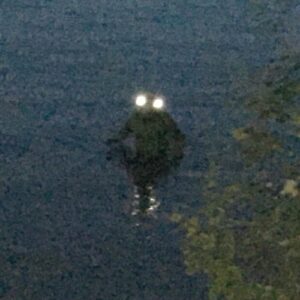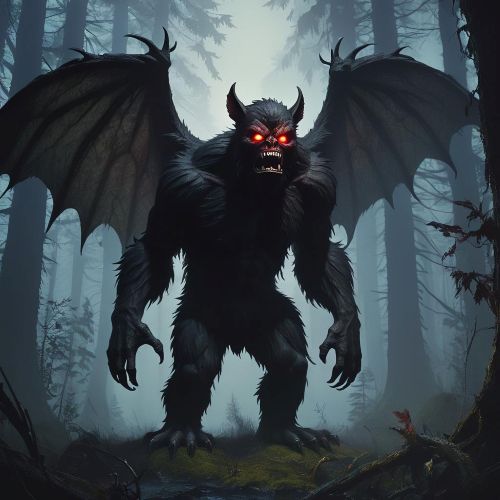Loveland Frog : The Amphibious Enigma
| Description | |
|---|---|
| Origin | United States of America |
| Classification | Cryptid |
| Demeanour | Neutral |
| Habitat | Lake |
| Status | Not Proved |

Introduction
Among America’s most intriguing cryptids, the Loveland Frog stands out for its unusual combination of amphibian traits and humanoid form. Rooted in the folklore of Loveland, Ohio, this frog-like figure has inspired curiosity since the mid-20th century, with stories circulating of strange encounters along the Little Miami River. Unlike giants such as Bigfoot or winged creatures like Mothman, the Loveland Frog is more mysterious than menacing. Its legend has grown from a handful of sightings into a cultural symbol for the city itself, proving that this peculiar amphibian is more than just a fleeting curiosity—it has become a lasting part of Ohio’s folklore.
Physical Attributes
Descriptions of the Loveland Frog share a consistent core, though witnesses have provided variations over the years. Most agree the creature stands between three and four feet tall, though some reports exaggerate its height to six feet or more. It is typically said to walk on its hind legs, resembling a squat human figure with an unmistakably frog-like head. The skin is described as leathery or scaly, ranging from green to gray, with bulging eyes that give it a reptilian appearance. Unlike ordinary frogs, it is said to have webbed hands as well as feet, making it capable of manipulating objects. Witnesses often note its wide, lipless mouth, wrinkled head, and surprisingly heavy build, with estimates placing its weight between fifty and seventy-five pounds. These descriptions blend the familiar features of a frog with unsettling humanoid traits, creating a cryptid image that is both eerie and captivating.
First Sighting/Reporting
The legend of the Loveland Frog began in 1955 with a sighting by a traveling businessman. Driving late at night along a road near Loveland, he claimed to have seen three frog-like figures standing upright on the roadside. Each was around four feet tall, with leathery skin and faces that resembled frogs. The most bizarre detail of this early encounter was the claim that one of the creatures carried a wand-like stick, which emitted sparks. This strange, almost magical element has kept folklorists debating whether the original story mixed myth with cryptid reporting.
The tale gained credibility in 1972, when police officer Ray Shockey spotted a creature near the Little Miami River. He described a leathery-skinned animal about three to four feet long that crouched like a frog before standing upright and scrambling over a guardrail. Just weeks later, another officer, Mark Matthews, reported a similar encounter. Matthews fired at the animal and later identified it as an iguana without a tail—likely a released pet. While this explanation satisfied skeptics, many argue that an iguana could not survive Ohio’s cold March weather, leaving the door open for speculation.
New stories have surfaced since, including a controversial 2016 report from two teenagers who claimed to see the Loveland Frog while playing Pokémon Go. Although dismissed by most as a prank, it shows how the legend continues to reappear in new contexts, keeping the frogman alive in the local imagination.
Other Names
The Loveland Frog is best known by its popular title, but several alternate names have attached themselves to the creature over time. “Loveland Frogman” is the most common variation, emphasizing its humanoid qualities, while “Loveland Lizard” occasionally appears in accounts, likely because of its scaly skin and reptilian aura. Some older traditions claim Indigenous groups in the area referred to a similar creature as the Shawnahooc, suggesting that stories of frog-like beings in the region may predate the mid-20th century sightings. These shifting names reflect the uncertainty about the creature’s true nature—whether it is amphibian, reptilian, or something entirely otherworldly.
Modus Operandi
The Loveland Frog’s behavior is as puzzling as its appearance. Most sightings take place at night, often along country roads or near riverbanks, underscoring its elusive and nocturnal tendencies. Witnesses typically report the creature darting quickly across roads or disappearing into water, suggesting it is shy rather than aggressive. Some accounts give it more unusual traits: in 1955, the so-called spark-emitting wand hinted at intelligence, even tool use. Others have claimed the creature can emit a strange odor, sometimes described as alfalfa or almonds. A few stories even portray frogmen communicating with each other in croaks or guttural sounds. Whether these details are embellishments or genuine observations, they add depth to the mystery, transforming the Loveland Frog from a simple anomaly into a cryptid with its own distinct patterns of behavior.
Pop Culture References
The Loveland Frog’s legend has expanded well beyond eyewitness accounts, cementing its place in American pop culture. It has appeared in books, musicals, films, and even trading card games. In 2012, James Renner’s novel The Man from Primrose Lane included a frogman character wielding the iconic spark-emitting wand, giving literary form to the legend. In 2014, Cincinnati’s Fringe Festival debuted the musical Hot Damn! It’s the Loveland Frog!, a humorous yet affectionate take on the local myth. More recently, the 2023 horror film Frogman revived the creature for a new generation of cryptid fans, framing it in the style of found-footage horror.
Beyond the arts, the frogman has entered gaming culture through the MetaZoo: Cryptid Nation trading card game. Online communities frequently reference the creature, and merchandise featuring the frogman can be found at local shops. Its transformation into a cultural mascot shows how folklore adapts, with the Loveland Frog moving from campfire story to a figure of local pride and entertainment.
Current Status
Despite its cultural impact, the Loveland Frog remains unverified as a biological entity. Skeptics point to misidentified animals, escaped pets, and hoaxes as explanations for the sightings. The iguana identified by officer Matthews in 1972 is often cited as proof, though others argue that Ohio’s climate would make such survival unlikely. Folklorists have suggested that the frogman legend grew in popularity during the 1950s, when monster movies like Creature from the Black Lagoon captured public imagination, making people more receptive to amphibious humanoids.
Nevertheless, the Loveland Frog has secured a permanent place in Ohio culture. In 2023, the city of Loveland officially adopted the creature as its mascot, reimagining it as a whimsical “frog prince” character that appears at parades and community events. While no scientific evidence supports the existence of the frogman, its role as a cultural icon is undeniable. Each new sighting, festival, or artistic adaptation breathes life into the legend, ensuring that the Loveland Frog continues to fascinate both locals and cryptid enthusiasts around the world.
Source
Margaritoff, M. (2024, June 15). The Loveland Frogman: The Humanoid Frog Of Ohio Legend. All That’s Interesting. https://allthatsinteresting.com/loveland-frogman
Wikipedia contributors. (2024). Loveland frog. Wikipedia. https://en.wikipedia.org/wiki/Loveland_frog
North American Cryptids. (n.d.). The Loveland Frog: A Legendary Creature of Ohio Folklore. https://northamericancryptids.com/loveland-frogmen







